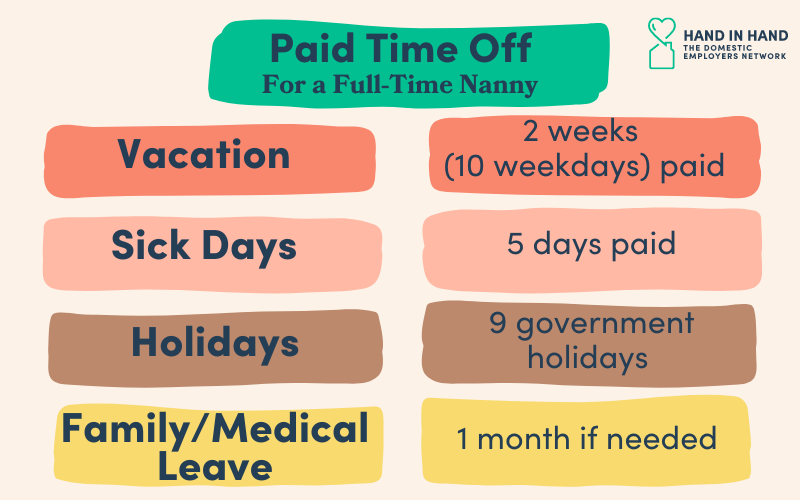
If you employ a nanny, it’s essential that you build Paid Time Off (PTO) into your arrangement, and ideally, into a written work agreement. Why?
Paid time off will ensure that the person you employ can take the time they need to care for themselves, is rested and healthy, and is therefore able to do their best work… and caring for your child(ren) is pretty important work!
Hand in Hand has gathered these recommendations from our years of experience working with nanny employers–and we’ve also consulted with our partners, the nannies and labor experts at National Domestic Workers Alliance (NDWA)–to put together the following guide to Paid Time Off.
What type of paid time off should I offer a nanny?
- Sick days
- Vacation days
- Holidays
- Family / medical leave
How much time off does a nanny get?
- If you employ a full-time nanny, offer at least 2 weeks of paid vacation and 5 paid sick days each year.
- If the nanny works part-time, they should earn 1 hour of vacation time for every 20 hours they’ve worked and 1 hour of sick time for every 30 hours worked.
- Give the nanny the major federal holidays, or agreed upon holidays of the employee’s choice. Maybe they’d like time off at Ramadan instead of Easter!
- Include at least one month of paid family or medical leave in your work agreement in the event that the nanny has a family or medical emergency. This should include a guarantee that they may return to work at the end of their leave.
Here’s that info again in chart form:

How to manage vacation and sick days with a nanny
Here are the routines and expectations we suggest using to implement Paid Time Off for the nanny you employ. As always, open communication will help avoid surprises and confusion for you both.
Here’s how time off works in practice:
- Nannies start earning their vacation time from their first day on the job, but it’s reasonable to ask the nanny not to use this time during the first three months.
- Vacation time should be scheduled in advance, ideally a month or more, together. Many employers want their vacation schedules to line up with the nanny’s, and that is a request that you can explore, but the nanny has the right to choose when they want to take vacation.
- Unused vacation time can roll over from year to year, but employers may cap the vacation accrual – for example, at 5 days total. At the end of the job, any vacation time the nanny has earned but not used should be paid out to them in full.
- Just as you might use one of your sick days to stay home with your sick child, the nanny may use their sick days to care for their own health or that of a family member. Remember that their household’s health and well being is connected to yours!
- Sick time is meant to be used only if needed, so it does not need to roll over from year to year the way vacation should, although you are certainly welcome to offer this.
What do I do when the nanny takes a sick day?
Plan in advance! You’ll want to have a back up care plan in mind for when the nanny you employ takes a sick day. Think through who might be able to step in at the last minute. Is there a family member or other relative who could help? Does a friend employ a nanny who is willing to take on your child(ren) for a day or 2 for additional compensation? Or do you have a relationship with a babysitter who might be available? Think through these questions and have some conversations in advance so you can more easily fill in a potential gap in childcare.
What if my child or I are sick?
If you or your child(ren) are sick then give the nanny the day(s) off with pay. This should not be counted as their sick time. You’ve budgeted for the expense and the nanny is expecting the income.
Similarly, if anyone in your household experiences symptoms or tests positive for COVID-19, suspend work with pay. Follow the CDC guidelines, and make sure that no one is contagious before inviting the nanny back into your home.
What national holidays should the nanny get to take off?
Provide paid holidays on the same holidays that schools, banks, and probably your own office are going to be closed!
These are: Christmas, New Year’s Day, July 4th, Labor Day, Thanksgiving, Martin Luther King Day, Memorial Day, Juneteenth, and Presidents’ Day.
If you do ask the nanny to work during any of these holidays (and they agree) they should be paid an overtime rate of 1.5 times their regular pay.
What’s a “day” of vacation or sick time for a part-time nanny?
A “day” off is defined as the average number of hours the nanny is contracted to work per day. Let’s say a nanny works five days a week, for 4 hours each day, from 9 a.m. to 1 p.m.,. When they request a Monday off, they will use 4 hours of vacation time to take that day off. They are paid as if they worked that day.

Do nannies get lunch hours and rest breaks?
Nannying can certainly be an intense job, and workers absolutely deserve to rest. However, it’s not possible for the nanny to go “off duty” while alone with your child! Do what you can to ensure the nanny has opportunities to take care of themself. If they take some time to rest while the child is napping, it is absolutely a paid lunch hour! Don’t expect them to eat a sandwich with one hand while folding onesies with the other.
Tracking nanny’s hours and time off
One of your responsibilities as the employer is to keep accurate records of the hours worked, as well as then tracking the paid time off the nanny has accrued and used.
You can do so by using a home payroll service, making a spreadsheet, or anything that works for you. Just be sure to provide an updated account of available and used PTO on payday.


